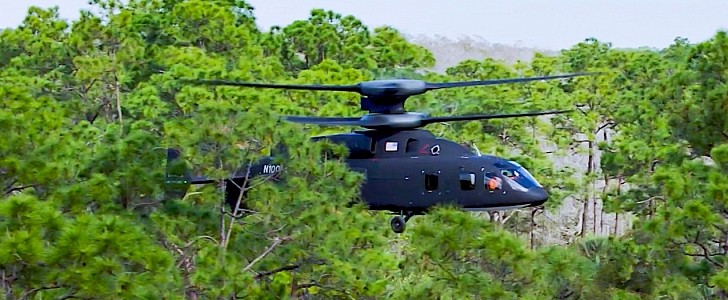Come the next decade, the U.S. military will have a brand new attack helicopter to play around with. More than a decade ago, America created something called the Future Vertical Lift program, which should result in a machine named Future Long-Range Assault Aircraft (FLRAA) taking to the skies over the world battlefields.
The SB-1 Defiant is the entry in this program being cooked up by the combined powers of Sikorsky and Boeing. We’ve talked about it here on autoevolution before, as it’s not every day we get to witness the birth of a beast that might shape the world for years to come.
The last time we talked about it was in August last year, when we learned about the helicopter’s lifting capabilities. This week, Boeing updated us on the progress by saying the helo nailed “confined area landings and low-level flight operations.”
According to the data made public, the helicopter that may become the replacement for the Army’s long-lived Black Hawk (there’s another candidate in the pipeline, Bell’s V-280 Valor) proved itself by flying at 236 knots (272 mph/438 kph) in level flight, then “reducing thrust on the propulsor to rapidly decelerate as we approached the confined, and unimproved, landing zone.”
“This type of level body deceleration allowed us to maintain situational awareness and view the landing zone throughout the approach and landing without the typical nose-up helicopter deceleration,” said in a statement Bill Fell, the helicopter’s chief flight test pilot.
“This confined area was extremely tight, requiring us to delay descent until nearly over the landing spot, followed by a near-vertical drop. We landed Defiant precisely on the objective with little effort as we descended into this narrow hole while maintaining clearance on all sides.”
During previous tests, the Defiant proved it can easily navigate 60-degree (and greater) banked turns, and lift a 5,300-pound (2.4 tons) Guided Multiple Launch Rocket System external load. And as you can see in the video below, it can lurk in low-level flight in the trees, stalking its prey.
The Defiant is slightly different from a conventional helicopter in terms of design. It has no tail rotor in the conventional sense, but comes with counter-rotating blades fitted on top and a vertical propeller at the rear.
It is operated via fly-by-wire controls, making it ideal for low-level rapid flying, and its targeted top speed of 245 knots (282 mph/454 kph) should make it “the fastest assault helicopter in history.”
The last time we talked about it was in August last year, when we learned about the helicopter’s lifting capabilities. This week, Boeing updated us on the progress by saying the helo nailed “confined area landings and low-level flight operations.”
According to the data made public, the helicopter that may become the replacement for the Army’s long-lived Black Hawk (there’s another candidate in the pipeline, Bell’s V-280 Valor) proved itself by flying at 236 knots (272 mph/438 kph) in level flight, then “reducing thrust on the propulsor to rapidly decelerate as we approached the confined, and unimproved, landing zone.”
“This type of level body deceleration allowed us to maintain situational awareness and view the landing zone throughout the approach and landing without the typical nose-up helicopter deceleration,” said in a statement Bill Fell, the helicopter’s chief flight test pilot.
“This confined area was extremely tight, requiring us to delay descent until nearly over the landing spot, followed by a near-vertical drop. We landed Defiant precisely on the objective with little effort as we descended into this narrow hole while maintaining clearance on all sides.”
During previous tests, the Defiant proved it can easily navigate 60-degree (and greater) banked turns, and lift a 5,300-pound (2.4 tons) Guided Multiple Launch Rocket System external load. And as you can see in the video below, it can lurk in low-level flight in the trees, stalking its prey.
The Defiant is slightly different from a conventional helicopter in terms of design. It has no tail rotor in the conventional sense, but comes with counter-rotating blades fitted on top and a vertical propeller at the rear.
It is operated via fly-by-wire controls, making it ideal for low-level rapid flying, and its targeted top speed of 245 knots (282 mph/454 kph) should make it “the fastest assault helicopter in history.”












